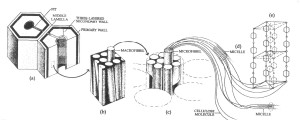MACROMOLECULAR COMPONENTS OF THE CELL WALL
Cellulose Is the Principal Component of Plant Cell Walls
The principal component of plant cell walls is cellulose, a polysaccharide with the empirical formula (C6H10O5)n. Its molecules are linear chains of (1→4)β-linked-D-glucan (repeating monomers of glucose attached end to end). These long, thin cellulose molecules tend to hydrogen bond together to form microfibrils. Considerable variation exists in the literature with respect to the diameter of microfibrils. Most values are in the range of 4 to 10 nanometers, although values as small as 1 and 2 nanometers and as large as 25 nanometers have been recorded.
The diameter of cellulose microfibrils apparently is highly dependent on the water content of the portion of wall being examined. Microfibrils of hydrated walls appear smaller than those of dehydrated walls. Water, located mainly in the matrix, makes up about two-thirds of the wall mass in growing tissues.
The cellulose microfibrils wind together to form fine threads that coil around one another like strands in a cable. Each “cable,” or macrofibril, which is visible with a light microscope, measures about 0.5 micrometer wide and can reach four to seven micrometers in length. Cellulose molecules wound in this fashion have a tensile strength (breaking strength) approaching that of steel (50–160 kg/mm2). Cellulose microfibrils constitute 20% to 30% of the dry weight of a typical primary wall and 40% to 60% of that of the secondary wall of wood cells. Cellulose has crystalline properties resulting from
the orderly arrangement of cellulose molecules in the microfibrils. Such arrangement is restricted to parts of the microfibrils that are referred to as micelles. Less regularly arranged glucose chains occur between and around the micelles and constitute the paracrystalline regions of the microfibril. The crystalline structure of cellulose makes the cell wall anisotropic and, consequently, doubly refractive (birefringent) when viewed with polarized light

The Cellulose Microfi brils Are Embedded in a Matrix of Noncellulosic Molecules
The cellulose microfi brils of the wall are embedded in a cross-linked matrix of noncellulosic molecules. These molecules are the polysaccharides known as hemicelluloses and pectins, as well as the structural proteins called glycoproteins. Principal Hemicelluoses Hemicellulose is a general term for a heterogeneous group of noncrystalline glycans that are tightly bound in the cell wall. The hemicelluloses vary greatly in different cell types and
among taxa. Generally, one hemicellulose dominates in most cell types, with others present in smaller amounts. Xyloglucans are the principal hemicelluloses of the primary cell walls of eudicots and about one-half of the monocots, comprising about 20% to 25% of their dry weight. The xyloglucans consist of linear chains of (1→4)β-D-glucan as in cellulose, with short side chains containing xylose, galactose, and often a terminal fucose. Most of the xyloglucans apparently are tightly hydrogen-bonded with cellulose microfibrils. Being tightly bound to the cellulose microfi brils, xyloglucan potentially limits the extensibility of the cell wall by tethering adjacent microfibrils and, hence, may play a significant role in regulating cell enlargement.
Degradative by-products of xyloglucans (xyloglucanderived oligosaccharides) exert a hormone-like antiauxin effect on cell growth. In addition in the seeds of some eudicots, for example, nasturtium (Tropaeolum), Impatiens, and Annona, xyloglucans located in thick cell walls constitute the principal storage carbohydrate. Xyloglucans apparently are lacking in the secondary cell walls (wall layers deposited inside the primary wall) of xylem elementsPrimary cell walls in which the principal hemicelluloses are xyloglucans have been designated Type I walls.